Midterm Study Guide
1/67
There's no tags or description
Looks like no tags are added yet.
Name | Mastery | Learn | Test | Matching | Spaced |
|---|
No study sessions yet.
68 Terms
Define Latent Learning
Learning without receiving rewards or punishments
Proponent: Edward Tollman
He also discovered cognitive map: mental representation of an area
Explain the Neuron Doctrine
Is a fundamental principle in neuroscience that describes…
Nervous system composition: individual, specialized cells called neurons.
How neurons communicate: at specialized junctions called synapses rather than in a continuous network (i.e. net theory)”
Who is a proponent of the Neuron Doctrine?
Santiago Ramon y Cajal
What is an action potential?
What is it?
A neural impulse/brief electrical charge that travels down axon
Function?
encode information and trigger the release of neurotransmitters to send messages throughout brain and body
How it works?
When a sufficient electrical signal is received → action potential is triggered → neurotransmitters released at the synapse → messages sent throughout body
What is a neurotransmitter?
a chemical messenger that transmits signals between neurons, essentially allowing nerve cells to communicate with each other by carrying "messages" across the tiny gap between them, known as the synapse
Differentiate action potential and neurotransmitters
An action potential is an electrical signal that travels along the axon of a neuron that triggers the release of neurotransmitters at the synapse.
The neurotransmitters are the chemical signals that cross the gap to the next neuron;
essentially, the action potential generates the signal within the neuron, while the neurotransmitter is what carries the signal/message across the synapse to the next neuron.
An action potential is the rapid electrical signal within a neuron
occurs in the axon
Is a "wave" of electrical activity that triggers release of neurotransmitter
A neurotransmitter is the chemical messenger
Is what’s released from the axon (terminal) after action potential
Carries the message
Crosses the synapse → bind to receptors of another neuron → connection allows for communication between two
Define feature detectors
Nerve cells that respond to specific features of a stimulus
(i.e. shape, angle, or movement)
Location:
visual cortex of brain
feature detectors proponent
David Hubel and Thorsten Wiesel
What is sensory code, and what are its two types
Sensory code is how neurons represent stimuli
Two types:
Specificity coding
Population coding
Specificity Coding
An individual specialized neuron fires to represent stimuli or various concepts

Population coding
A large ensemble of neurons fire to represent stimuli or various concepts
A population of neurons required

Differentiate specificity and population coding
specificity coding focuses on individual neuron activity, while population coding relies on the collective activity of many neurons to represent information.
Example:
Specificity coding:
If a single "grandmother cell" in the brain only fires when you see your grandmother, that would represent specificity coding.
Population coding:
If a group of neurons in the visual cortex collectively encode the features of a face (like eye shape, nose shape, mouth position), with no single neuron solely representing the entire face, that would be an example of population coding.
Explain localization of function
"Localization of function" refers to the concept that specific areas of the brain are dedicated to performing particular functions
different parts of the brain control different behaviors and cognition
Is memory localized?
No
Jean Pierre Flourens
Lesioned specific brain regions, discovered memory was not affected by which area was destroyed
Who are proponents of localization?
John Hughlings Jackson
suggested that each muscle in the body was controlled by a specific region of the brain
Marc Dax/Paul Broca
Discovered damage in specific area of left hemisphere in patients with “expressive aphasia”
“broca’s area”
Carl Wernicke
Discovered a separate brain region in the left hemisphere associated with “receptive aphasia”, also known as language reception (cannot decode language)
“Wernicke’s Area”
Wilder Penfield
Pioneer of brain mapping
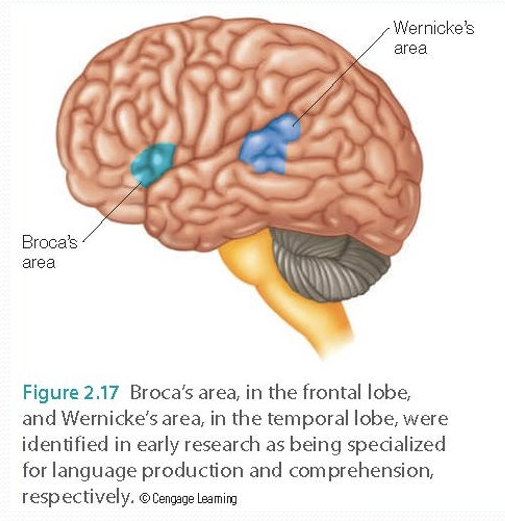
What is a lesion in the brain?
Destroyed brain or glial matter
May be incidental by surgery or from stroke, tumor, epilepsy, blunt trauma, etc.
May be intentional (brain ablation) to determine function of brain of nonhuman animal
What is double dissociation?
Patients with a specific lesion are compared with…
Control group
Patients with lesions in brain area A
Patients with lesions in brain area B
Purpose: To identify specialized functions by comparing two patients.
Explain the significance of double dissociation
a double dissociation provides stronger evidence that the impact on cognitive function(s) due to lesions are independent of each other.
Define distributed representation
A stimulus activates multiple areas of the brain to fully comprehend all aspects of a presenting stimulus.
mnemonic: Information is distributed across the brain.

Sensation
the activation of sensory organs and nervous system once they receive stimulus information from the environment
activation of sensory organs by stimuli
Perception
The conscious process of interpreting, organizing, and analyzing sensory information
enables us to recognize meaningful objects and events
Differentiate sensation and perception
Sensation is the physical process of detecting and receiving sensory information
Perception is the conscious interpretation of that stimulus.
What factors make pattern recognition more difficult (?)
Inverse projection
image clutter
What is the inverse projection problem and how does it make pattern recognition more difficult
The idea that a single image on the retina could be caused by various different stimuli.
The problem is we could very well perceive what we’re seeing as WRONG
EX: different objects at varying distances can cast the same retinal image, making it impossible to definitively know the true object without additional information or context clues. Is this person REALLY holding a tiny Eiffel Tower in her hand?
What is the image clutter problem, and how does it make pattern recognition more difficult
When many overlapping objects are scattered throughout a scene at once, object recognition becomes difficult— we cannot make sense of what we’re seeing

Bottom-up processing
More “simple” processing in that perception is guided merely by the basic features; refers to interpreting information based solely on the sensory input received, without relying on prior knowledge
starts with raw data and builds upwards
EX:
Top-down processing
Using existing knowledge and expectations to interpret new sensory information, essentially guiding perception with pre-existing ideas about the world
More “applied” processing in that perception is guided by assumptions, experience, and expectations
starts with known info and applies to basic perceptions
Differentiate bottom-up and top-down processing
Bottom-up processing involves building perceptions based solely on incoming sensory information, without relying on prior knowledge
Top-down processing involves using existing knowledge and expectations to interpret sensory information, essentially "filling in the gaps" based on what you already know
In simpler terms, bottom-up processing starts with the details and works towards a whole picture, whereas top-down processing starts with a general idea and uses it to interpret details.
Define perceptual set
a sub-category of top-down processing
a mental predisposition to perceive one thing and not another
ex: Whichever image, left or right, you're exposed to first influences your perception of the middle image-- in a sense, its like you’re priming the person to perceive a specific image.
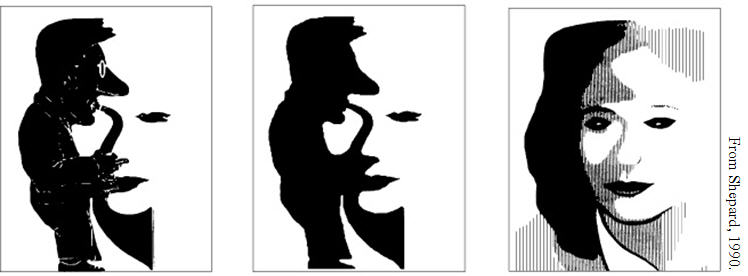

Define closure
a psychological principle where the mind perceives incomplete shapes or patterns as whole objects. This concept illustrates how our brain fills in gaps in visual information to create a complete picture, demonstrating the tendency to see things as unified and complete rather than fragmented.
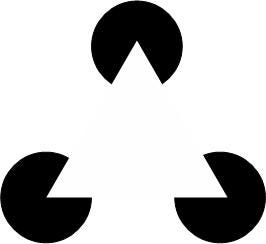
This image suggests the presence of a white triangle, even though there isn’t one, due to how the objects in the image are arranged, which strongly suggests there should be one there
Explain Bayesian Inference (prior probability and likelihood)
Bayesian inference: the use of mathematical probabilities to describe the process of perceptual inference
Prior: initial belief about the chances of an outcome
Likelihood: the extent to which the available evidence is consistent with an outcome
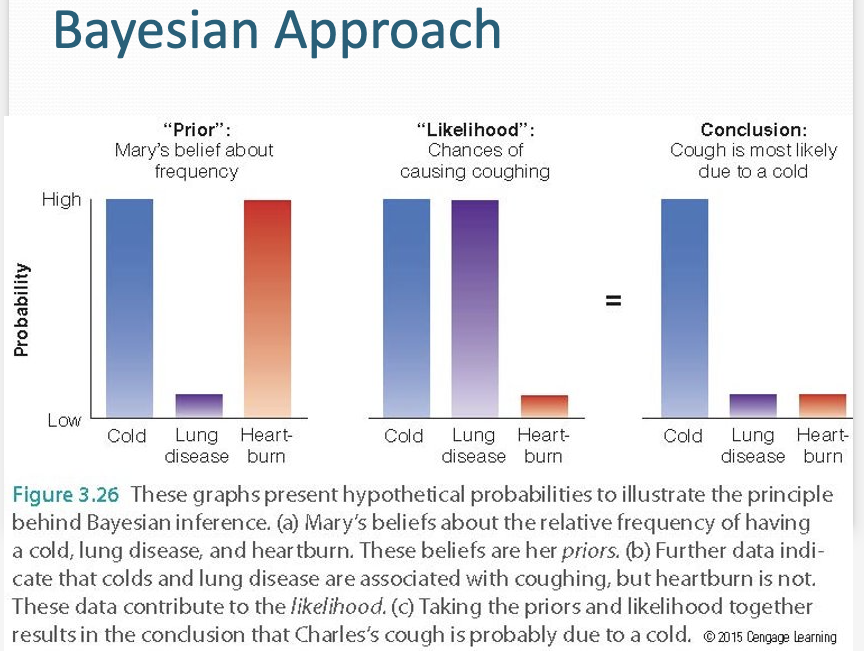
Define Plasticity
the brain's ability to adapt (or change) in response to experiences, learning, damage, or environmental stimuli.
Allows the brain to form new neural connections, strengthen existing connections, weaken or prune unnecessary connections, recover from brain injuries, learn new skills, and recognize new types of stimuli
most apparent in children
Define the Stroop task
naming colors takes longer when the word and the color it’s printed in are incongruent
Conflicting messages make responding quickly harder
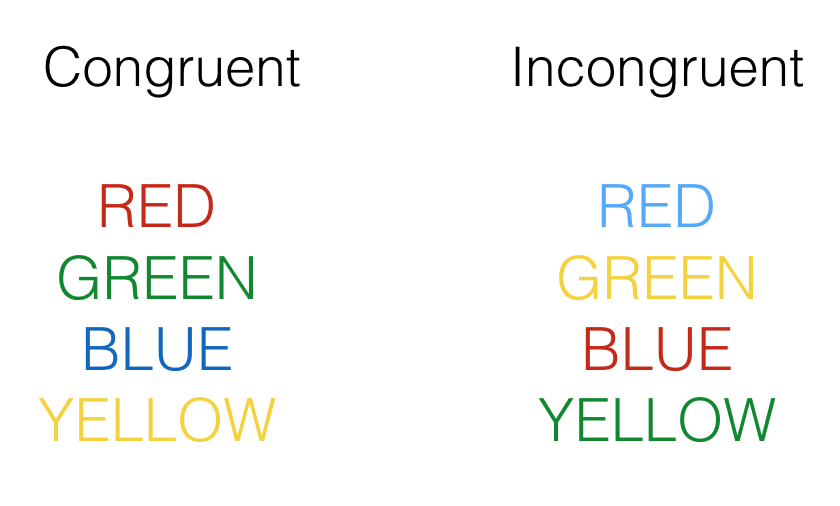
Emotional Stroop task: naming the color of words that provoke strong emotions takes longer
Attentional bias: some people pay particular attention to certain kinds of stimuli
Why do people have difficulty with the Stroop task
it creates a conflict between the automatic process of reading words and the intentional process of identifying colors, meaning that when presented with a word written in a different color, the brain is naturally inclined to read the word rather than state the color, leading to interference and slower response times when the color and word don't match; essentially, the brain is trying to perform two competing tasks at once.
Define change blindness
Failing to detect a change in a scene or object

Define inattentional blindness
when attending to certain things, we often completely miss things we aren’t attending to
Explain the binding problem of attention
we analyze features of stimuli separately, but we perceive them holistically
Explain the isolated features/combined feature effect
visual search tasks (finding a target in a visual display with many distracters) are easier when the target stimulus differs from all the background stimuli on a single feature as opposed to when multiple features must be processed
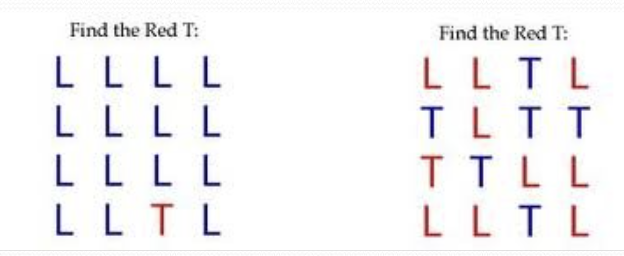
Explain the feature present/feature absent effect
people can locate a feature that is present quicker than an absent feature
Recall
a measure of memory in which the person must retrieve information learned earlier without help, as on a fill-in-the-blank test.
Recognition
a measure of memory in which the person identifies (or recognizes) items previously learned with help, as on a multiple-choice test.
Differentiate recall and recognition
recall is actively remembering details, while recognition is passively identifying something familiar
Recognition is the ability to recognize something you have seen before, while recall is the ability to remember something without being prompted. Recognition takes less cognitive effort.
What is the 3-stage modal model?
Sensory memory
Short-term (or working) memory
Long-term memory
Sensory memory
The immediate, very brief and accurate, recording of sensory information in memory.
1 second
Two types: Echoic and Ionic
Short-term (working) memory
activated memory that holds 4-7 units of info briefly, such as digits of a phone number while calling, before the information is stored or forgotten.
30 seconds
Long-term memory
the relatively permanent and limitless storehouse of the memory system; Includes knowledge, skills, and experiences.
Enduring (meaning it has the potential to last a lifetime)
Differentiate…
sensory memory
short-term/working memory
long-term memory
Sensory memory is the brief initial perception of sensory information, lasting only fractions of a second
Short-term memory holds information for a few seconds to minutes
Long-term memory stores information for extended periods, potentially a lifetime, with a much larger capacity than the other two
Sensory memory is the first stage where information enters the brain, then moves to short-term memory if attention is paid, and finally may be transferred to long-term memory for permanent storage.
Implicit (procedural) memory
Retention of learned skills or classically conditioned associations
Unconscious
Explicit (declarative) memory
Recollection of facts, events, or concepts that one can “declare”
Conscious
Two Types:
Semantic
Episodic
Differentiate Explicit (declarative) vs Implicit (procedural) memory
Explicit (declarative) memory refers to consciously recalling facts and events,
while implicit (procedural) memory involves the unconscious knowledge of how to perform a skill, without actively thinking about it
a) Episodic memory
Part of explicit (conscious) memory systems
Recollection of personally experienced events.
Remembering specific timeframes of events in our life
Events of our life we can play out like an episode; we can take ourselves back to that time and place as if we’re there
b) Semantic memory
2/2 explicit (conscious) memory systems
Recollection of facts and general knowledge.
things u learn in school (dates, names, etc)
Differentiate episodic and semantic memory
Episodic memory refers to the recollection of personal experiences and specific life events, including details like when and where they occurred, while semantic memory stores general knowledge and facts about the world, devoid of personal context or specific timeframes; essentially, episodic memory is "remembering" a specific event, while semantic memory is "knowing" a fact
Proactive interference
Older info disrupts the retrieval of newly learned info
(Pro → new)
Retroactive interference
Newly learned info disrupts retrieval of old info
(Retro → old)
Differentiate proactive and retroactive interference
"old" information interferes with "new" in proactive interference, and "new" information interferes with "old" in retroactive interference
How many units of information did Miller suggest we can store in working memory?
4-7 units
Explain apparent motion
a visual illusion in which two stimuli separated in time and location are perceived as a single stimulus moving between the two locations due to persistence of vision
Differentiate the components of working memory: Phonological loop and Visuospatial sketchpad
The phonological loop is working memory for sounds
The visuospatial sketchpad is the working memory for visual stimuli and for the physical layout of objects in an environment
Define object permanence
objects continue to exist even when not sensed
infants lack this
Explain the serial position effect (primacy and recency)
(recency effect) our tendency to recall items last in a list best
Related to short-term memory
(primacy effect) our tendency to recall items first in a list best
Related to long-term memory
Retrograde amnesia
an inability to retrieve information from one's past.
Anterograde amnesia
an inability to form new memories.
Define priming
the activation, often unconsciously, of certain associations, thus predisposing one's perception, memory, or response.
preparing us to respond a certain way
Define the Propaganda Effect
statements that have been heard before are more likely to be assumed as true
Define Mere Exposure Effect
the phenomenon that repeated exposure to novel stimuli increases liking of them.
Explain what was learned from studying Henry Molaison
Hippocampi removed → can’t form long-term explicit (declarative) memories, can still form long-term implicit (procedural) memories
cannot create new memories, but can remember older memories
trapped in the present
Explain what was learned from studying Clive Wearing
Hippocampi damage due to a virus→ anterograde and retrograde amnesia for episodic memories